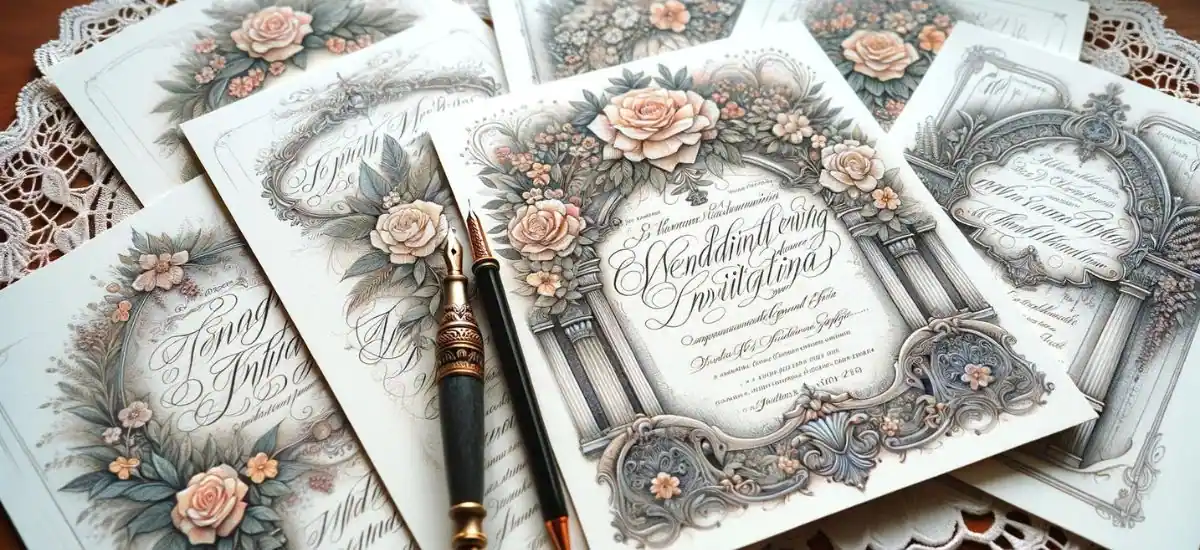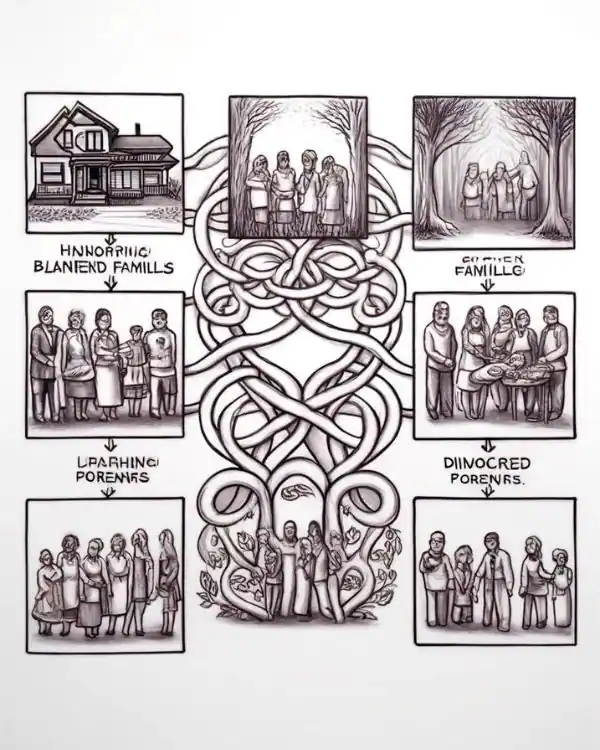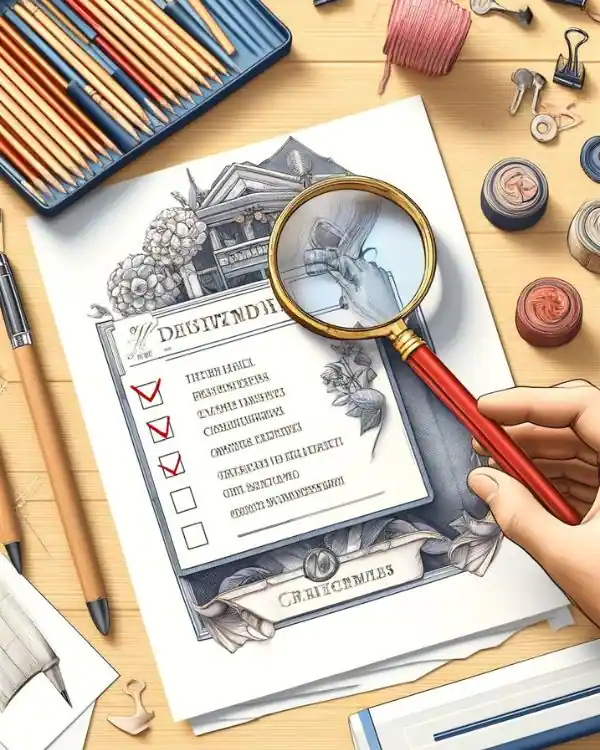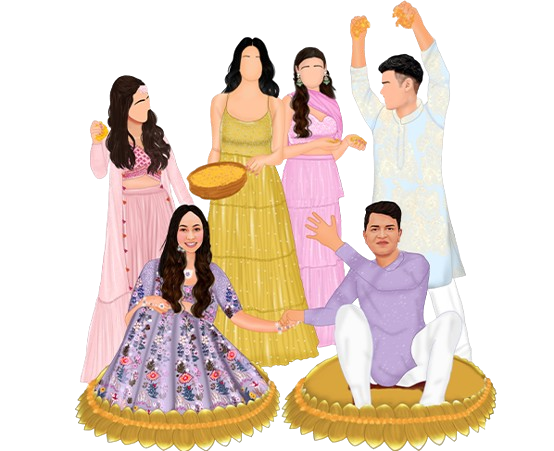Advertisement
By IS Team
Traditional Meets Trendy: Wedding Invitation Wording For 2024

Advertisement
Traditional wedding invitation wording combines formality and elegance to honor the occasion and the guests. The essence lies in using full names, formal titles, and a structured layout that includes a host line, request line, and details about the event.
Carefully crafted phrases such as "request the honor of your presence" exemplify the dignified tone expected in these invitations. These elements not only respect traditions but also set the celebratory tone, ensuring that the invitations resonate with heartfelt warmth and welcome.
This approach ensures that every detail in the wording reflects the significance and solemnity of the union.
Traditional Wedding Invitation Etiquette
Advertisement

When it comes to wedding invitations, etiquette is essential. Proper etiquette ensures that your invitations convey respect and set the tone for your event. Here are the key components you need to know:
Addressing Guests:
- Use formal titles like Mr., Mrs., Dr., etc.
- List full names, including middle names if possible.
- For married couples, list the husband's name first; for unmarried couples living together, list names alphabetically by last name.
Language Formality:
- Use formal phrases such as “request the honor of your presence” for traditional settings like church weddings.
- For less formal venues, phrases like “would love for you to join us” are suitable.
Invitation Structure:
- Host Line: Indicate who is hosting the wedding, traditionally the bride's parents.
- Date and Time: Write these out fully, avoiding abbreviations (e.g., “Saturday, the fifth of June, at half-past five in the evening”).
- RSVP: Include a deadline for responses and contact information or a pre-addressed RSVP card.
Additional Details:
- Mention the dress code if applicable.
- Provide directions and accommodation information for out-of-town guests.
- If the ceremony and reception are at different locations, provide details for both.
Following these etiquette guidelines helps ensure that your wedding invitations are both elegant and informative, setting a respectful and celebratory tone for your big day. 💌🎩
Components of a Traditional Wedding Invitation
- Invitation Line: Who's taking the initiative to invite? Typically, it’s the bride's parents, but modern variations are increasingly common.
- Request Line: This is where you actually "request the honor" of your guests' presence. The phrasing here sets the tone for the entire event.
- Names of the Bride and Groom: Traditionally, the bride’s name precedes the groom's, but all's fair in love and wedding planning!
- Date and Time: Stick to traditional formatting, like "the fifth of June, two thousand twenty-four at half-past five in the evening."
- Venue Information: Elegance is key. Detail the place where you will tie the knot, and make sure it’s as picturesque in words as it is in person.
- Reception Information: If it's happening elsewhere, provide details that entice and inform.
Language and Tone for Traditional Invitations
Advertisement

Choosing the right language and tone for your traditional wedding invitations is crucial. It sets the stage for your wedding's formality and elegance. Here are some tips to ensure your invitations sound both respectful and grand:
Choose a Formal Tone:
- Use a polished and refined style of writing.
- Include phrases like "the honor of your presence" or "requests the pleasure of your company" to maintain a high level of formality.
Use Full Names and Titles:
- Address guests by their full names, including any middle names or initials.
- Apply appropriate titles such as Mr., Mrs., Dr., etc., to show respect and adhere to traditional standards.
Crafting the Invitation Line:
- Tailor the invitation line based on who is hosting. For example:
- If parents are hosting: “Mr. and Mrs. [Last Name] request the pleasure of your company at the marriage of their daughter...”
- If the couple is hosting: “Together with their families, [Bride’s Full Name] and [Groom’s Full Name] joyfully invite you to their wedding...”
- Tailor the invitation line based on who is hosting. For example:
Consistency in Language:
- Ensure that the tone and style are consistent throughout the invitation. This includes the main invite, RSVP card, and any additional information.
Honoring Traditions:
- If you are blending cultural or family traditions, reflect this in the wording while keeping the tone respectful and formal.
- If you are blending cultural or family traditions, reflect this in the wording while keeping the tone respectful and formal.
By adhering to these guidelines, your wedding invitations will convey a sense of dignity and elegance, perfectly setting the tone for your special day. 💌🎩
Cultural Variations in Traditional Invitations
Advertisement
Advertisement
Wedding invitations vary greatly across cultures, each bringing its unique traditions and styles to the celebration. Understanding these differences can help you appreciate the diversity and beauty of wedding customs worldwide. Here are five examples of how traditional invitation wording differs across cultures:
Western (American/European) Traditions:
- Typically, the bride's parents host, and the invitation is formally worded to reflect this: “Mr. and Mrs. [Last Name] request the honor of your presence at the marriage of their daughter...”
- The tone is formal, using full names and no nicknames.
South Asian (Indian) Traditions:
- Invitations often include the names of both the bride's and the groom's parents, reflecting the importance of family: “Mr. and Mrs. [Bride’s Last Name] and Mr. and Mrs. [Groom’s Last Name] cordially invite you...”
- The wording can be elaborate, with blessings or religious verses added to invoke divine grace.
East Asian (Chinese) Traditions:
- Invitations often feature red and gold colors, symbolizing luck and prosperity.
- The wording typically includes blessings or phrases about good fortune: “We invite you to share in our joy and celebrate our good fortune as our families unite.”
Middle Eastern Traditions:
- The invitation might include poetic language and phrases from religious texts to bless the event.
- It’s common to mention both families extensively, reflecting the union of two families rather than just two individuals: “Together with their families, [Bride’s Name] and [Groom’s Name] request the pleasure of your company...”
African Traditions:
- Invitations may include tribal symbols or adages that reflect the couple’s heritage.
- The wording often emphasizes community and extended family, with invitations extending to a broad circle: “The families of [Bride’s Name] and [Groom’s Name] joyfully invite you to witness and celebrate their union...”
These examples show how cultural backgrounds influence the formality, language, and symbolism in wedding invitations, each tailored to celebrate heritage and shared values. By incorporating these elements, invitations become more than just a request to attend; they're an expression of cultural identity and familial pride. 🌐✨
Special Circumstances in Invitation Wording
Advertisement

Navigating complex family dynamics with grace ensures everyone feels included and respected in your wedding invitations. Here’s how to address some common special circumstances:
Blended Family Names:
- For families where parents have remarried: “Mr. and Mrs. [Stepfather's Last Name] and Mr. and Mrs. [Mother's Last Name] along with Mr. and Mrs. [Father's Last Name] and Mrs. [Stepmother's Last Name] invite you to the wedding of their children…”
Honoring Deceased Loved Ones:
- To honor those who have passed: “In loving memory of [Deceased Loved One’s Name], [Bride’s Name] and [Groom’s Name] invite you to witness their union.”
Divorced Parents Hosting Together:
- When divorced parents co-host: “Mrs. [Mother's Last Name] and Mr. [Father's Last Name] request the pleasure of your company at the marriage of their daughter…”
- When divorced parents co-host: “Mrs. [Mother's Last Name] and Mr. [Father's Last Name] request the pleasure of your company at the marriage of their daughter…”
These approaches ensure the invitation reflects respect for all family members, fostering an atmosphere of unity and inclusivity.
RSVP and Additional Information
The RSVP card is essential for managing your event logistics effectively. Here’s a quick guide to using both traditional and modern RSVP approaches and including crucial additional information:
RSVP Approaches:
- Traditional: Include a pre-stamped and addressed return card to make it easy for guests to respond.
- Modern: Offer options like email or wedding website RSVPs for convenience.
Additional Details:
- Dress Code: Clearly state the expected attire (e.g., black tie, semi-formal).
- Adult-Only: If your event is adult-only, explicitly mention this to avoid any misunderstandings.
Effective communication on your RSVP and additional details ensures your guests are well-prepared, contributing to a seamless wedding day. 📬🎉
Proofreading and Finalizing Your Invitation
Advertisement

Ensuring your wedding invitations are error-free is crucial before they're sent out. Here are some proofreading tips to help you avoid common mistakes and ensure your invitations are flawless:
Double-Check Names and Titles:
- Verify the spelling of all names, including guests, hosts, and venues.
- Ensure that titles (Mr., Mrs., Dr., etc.) are correctly used and placed.
Review Dates and Times:
- Confirm the accuracy of the date, time, and day of the week.
- Double-check the sequence of events and their corresponding times.
Grammar and Punctuation:
- Look for common grammatical errors and correct punctuation usage.
- Read the invitation aloud to catch awkward phrasings or run-on sentences.
Consistency Check:
- Ensure consistency in font styles, sizes, and colors throughout the invitation suite.
- Verify that the tone and style are uniform across all pieces.
Get a Second Opinion:
- Have someone else review the invitation. A fresh pair of eyes can spot errors you might have missed.
Final Overview:
- Give your invitations one last read-through before they go to print.
- Check that all additional information (maps, RSVP cards) is included and accurate.
Taking the time to carefully proofread your wedding invitations ensures they look professional and convey the importance of your special day. Remember, this invitation is not just a formality; it's the first impression of your wedding! ✔️💌
In crafting your traditional wedding invitations, remember that every word you choose sends a message about your big day. With the right mix of respect for tradition and a personal touch, your invitations will not only inform but also delight your guests. Get ready to set the stage for your wedding with elegance and style! 🌟💒
Advertisement
Frequently Asked Questions
Can I include a quote or verse in my traditional wedding invitation? Yes, adding a quote or verse is acceptable in traditional wedding invitations, especially if it reflects the couple’s values or religious beliefs. Ensure it complements the overall tone and formality of the invitation.
Is it appropriate to use symbols or emblems in traditional invitations? Symbols or family crests can be included in traditional wedding invitations to add a personal touch or honor heritage. They should be placed discreetly and tastefully to maintain the invitation’s elegance.
How do we handle invitations for a destination wedding? For destination weddings, traditional wording still applies, but it's crucial to provide additional information about the location, travel details, and accommodations to assist guests in planning their travel.
What’s the best way to indicate a change of venue or date after invitations have been sent? If there’s a change in details after invitations are sent, it's appropriate to send a follow-up note or card as soon as possible. Keep the message formal and apologetic for any inconvenience caused.
Advertisement
I'm Looking For!








